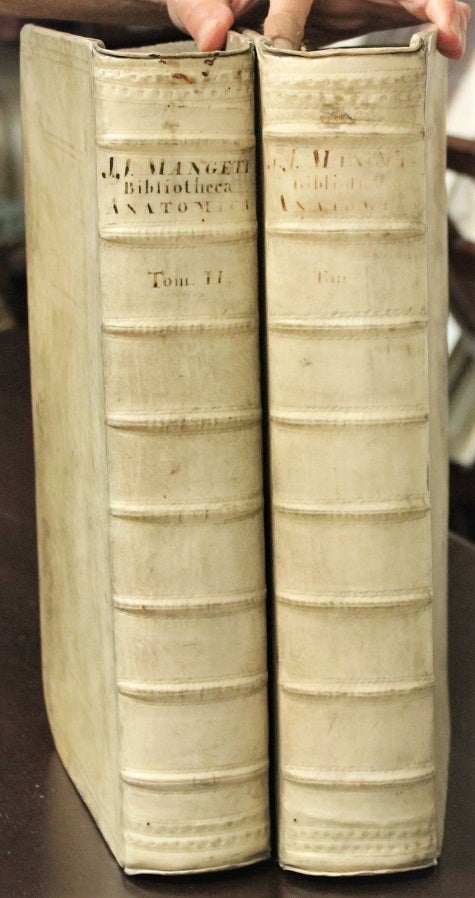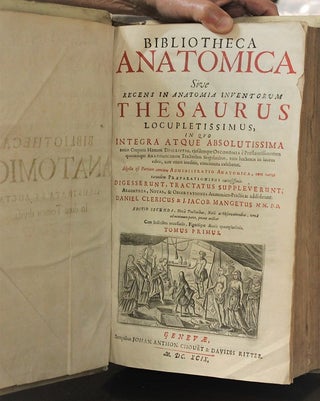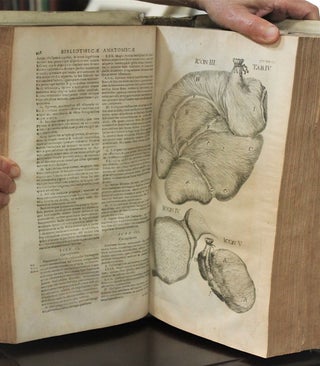BIBLIOTHECA // ANATOMICA // Siue // RECENS IN ANATOMIA INVENTORUM // THESAURUS // LOCUPLETISSIMUS, // IN QVO // INTEGRA ATQUE ABSOLUTISSIMA // .... GENEVAE; // Sumptibus JOHAN. ANTHON CHOUET & DAVIDIS RITTER. // M. D C. XCIX.
Genevae: Johan. Anthon Chouet & David Ritter. 1699. Edition: Second, augmented edition. Text in Latin; occasion, Binding: Contemporary, gilt panelled vellum; boards with central gilt ornamental design; spine raised with eight (8) bands and gilt lettered title on two and three; all edges cut., Notes: The Bibliotheca Anatomica is a two volume, compendium of human anatomy of the seventeenth century, edited by the physicians Daniel Le Clerc or LeClerc and Jean-Jacques Manget from Geneva. The work was first published in Geneva in 1685; its second, augmented edition, of which the present copy is a rare example, was published in 1699 - by Johan Anthon Chouët and Davidis Ritter. The text of this second edition is augmented by numerous engraved plates.
It encompasses 'almost all significant anatomical publications across the several decades prior to its publication, including writings of many physicians, including the ones mentioned below. Bibliotheca Anatomica is the most comprehensive collection of anatomical treatises produced in the 17th century.' Keynes states: ‘This compilation includes almost all the most important anatomical texts of the century'. Russell calls it an ‘extraordinary storehouse of seventeenth century anatomical works’(R. 524).
Jean-Jacques Manget or Johann Jacob Mangetus (1652–1742) was a Genevan physician and writer. He was known for his work on epidemic diseases such as bubonic plague and tuberculosis... and... considered one of the "great compilers" of knowledge in the areas of medicine, surgery and pharmacology. Manget became Dean of the Valence medical faculty. Frederick III, Elector of Brandenburg appointed him his personal physician in 1699.
Daniel Le Clerc or Leclerc (1652-1728) co-edited the groundbreaking 'Bibliotheca Anatomica' with Manget. Moreover, he authored the seminal 'Histoire de la Medecine', a work unique in its time, going beyond describing the current state of the art of medicine, but delving into the history of medical knowledge from ancient times to the then present. He drew heavily upon Al-Tamimi's seminal work, al-Murshid, upon which he based his views on dietetics and medicines. Le Clerc was elected to the Council of Two Hundred in 1701, a position he held until his death in 1728.
Thomas Willis (1621 – 1675) was an English doctor who played an important part in the history of anatomy, neurology and psychiatry. ...Willis was a pioneer in research into the anatomy of the brain, nervous system and muscles. His most notable discovery was the "Circle of Willis", a circle of arteries on the base of the brain.
Theodor Kerckring or Dirk Kerckring (sometimes Kerckeringh or Kerckerinck) (?- 1693) was a Dutch anatomist and chemical physician. ...Kerckring is remembered for his Spicilegium anatomicum, which is an anatomical atlas of clinical observations, medical curiosities, autopsy discoveries along with general anatomical information. He is credited with describing "Kerckring's ossicles", which is an occasional ossification centre in the occipital bone that appears around the 16th week of gestation.
Marcello Malpighi (10 March 1628 – 29 November 1694) was an Italian biologist and physician, who is referred to as the "Founder of microscopical anatomy, histology & Father of physiology and embryology”.
Raymond Vieussens (ca. 1635 – 16 August 1715) was a French anatomist. ...Vieussens is credited as being the first physician to give accurate descriptions of the left ventricle and several blood vessels of the heart. Several ... anatomical structures were named after Vieussens, however they have largely been replaced by clinical nomenclature.
William Harvey (1578 – 1657) was an English physician who made influential contributions in anatomy and physiology. He was the first known physician to describe completely, and in detail, the systemic circulation and properties of blood being pumped to the brain and the rest of the body by the heart, though earlier writers, such as Realdo Colombo, Michael Servetus, and Jacques Dubois, had provided precursors of the theory.
Richard Lower (1631 –1691) was an English physician who heavily influenced the development of medical science: He is most remembered for his works on transfusion and the function of the cardiopulmonary system (Tractatus de Corde).
Jean Pecquet (1622 - 1674) was the French anatomist who discovered the thoracic duct and the differences of vein and lymphatic vessels. In 1666, he was appointed anatomist to the Académie (Royale) des Sciences; there he participated in transfusion experiments. ...between 1666 and 1670, he was appointed personal doctor to the King.
Thomas Bartholin or Thomas Bartholinus (1616 – 1680) was a Danish physician, mathematician, and theologian. He is best known for his work in the discovery of the lymphatic system in humans and for his advancements of the theory of refrigeration anesthesia, being the first to describe it scientifically.
Olaus Rudbeck or Olof Rudbeck the Elder (1630 – 1702) was a Swedish scientist and writer, professor of medicine at Uppsala University and for several periods rector magnificus of the same university. Rudbeck is primarily known for his contributions in two fields: human anatomy and linguistics... Rudbeck was one of the pioneers in the study of lymphatic vessels.
Thomas Wharton (1614–1673) was an English physician and anatomist best known for his descriptions of the submandibular duct (one of the salivary ducts) and Wharton's jelly of the umbilical cord....
Regnier or Reinier or Reijnerus de Graaf or de Graeff (1641 – 1673) was a Dutch physician and anatomist who made key discoveries in reproductive biology. ...
The physician Eyssonius, Henricus (1620-1690) focussed on the study of genealogy of gynaecology.
Charles Drelincourt (1633 - 1697) was a French physician. From 1656 to 1658, he was appointed Inspector in Flanders in the army's medical service; in 1659 he was elevated to the rank of first physician of Louis XIV.
Giovanni Alfonso Borelli (1608 – 1679) was a Renaissance Italian physiologist.... He contributed to the modern principle of scientific investigation by continuing Galileo's practice of testing hypotheses against observation. ... he made extensive studies of ... the mechanics of animal locomotion and, in microscopy, of the constituents of blood. ...Borelli's major scientific achievements are focused around his investigation into biomechanics. This work originated with his studies of animals. His publications, De Motu Animalium I and II.
Jan Swammerdam (1637 – 1680) was a Dutch biologist and microscopist. His work on insects demonstrated that the various phases during the life of an insect—egg, larva, pupa, and adult—are different forms of the same animal. As part of his anatomical research, he carried out experiments on muscle contraction. In 1658, he was the first to observe and describe red blood cells. He was one of the first people to use the microscope in dissections, and his techniques remained useful for hundreds of years.
, Size: Folio (357x213 mm). , Illustration: Each volume illustrated with red and black title and large engraved frontispiece vignette, numerous initial wood cuts, head- and tail pieces; scores of in-text wood cuts, ranging in size from small to full page, including at least 3 full-paged (plus one table), 7 half-paged, 21 third-paged. Moreover 124 engraved plates: of these, 80 full-page plates, 34 approximately full page or slightly larger folding plates, plus 10 approximately double paged folding plates. , Volume: 2 volume compendium. , References: ABPC: 75; BM 14: 1110, p. 736; General Info: Cushing L: 111; Keynes, Harvey Bibliography, 3rd edition, p. 101; Krivatsy: 6760; Osler: 3192; Russell: 388; Wellcome III: p. 320 & 470. , Pages: Ff: Vol I: Bl. (2), Ґ1-8, Ԓ1-6, a1-i6, k1-8; A1-Zzz6, Aaaa1-Tttt6, Vvvv1-8, bl.(2); bl. (2), title, A1-Kk6, [4unnumbered], Ll1-Zzzz6, Aaaaa1-Iiiii6, Kkkkk1-4, bl.(2) [124 ill]., Category: Book Medical;. A very good example. Item #B6532
Edition: Second, augmented edition. Text in Latin; occasion, Binding: Contemporary, gilt panelled vellum; boards with central gilt ornamental design; spine raised with eight (8) bands and gilt lettered title on two and three; all edges cut., Notes: The Bibliotheca Anatomica is a two volume, compendium of human anatomy of the seventeenth century, edited by the physicians Daniel Le Clerc or LeClerc and Jean-Jacques Manget from Geneva. The work was first published in Geneva in 1685; its second, augmented edition, of which the present copy is a rare example, was published in 1699 - by Johan Anthon Chouët and Davidis Ritter. The text of this second edition is augmented by numerous engraved plates.
It encompasses 'almost all significant anatomical publications across the several decades prior to its publication, including writings of many physicians, including the ones mentioned below. Bibliotheca Anatomica is the most comprehensive collection of anatomical treatises produced in the 17th century.' Keynes states: ‘This compilation includes almost all the most important anatomical texts of the century'. Russell calls it an ‘extraordinary storehouse of seventeenth century anatomical works’(R. 524).
Jean-Jacques Manget or Johann Jacob Mangetus (1652–1742) was a Genevan physician and writer. He was known for his work on epidemic diseases such as bubonic plague and tuberculosis... and... considered one of the "great compilers" of knowledge in the areas of medicine, surgery and pharmacology. Manget became Dean of the Valence medical faculty. Frederick III, Elector of Brandenburg appointed him his personal physician in 1699.
Daniel Le Clerc or Leclerc (1652-1728) co-edited the groundbreaking 'Bibliotheca Anatomica' with Manget. Moreover, he authored the seminal 'Histoire de la Medecine', a work unique in its time, going beyond describing the current state of the art of medicine, but delving into the history of medical knowledge from ancient times to the then present. He drew heavily upon Al-Tamimi's seminal work, al-Murshid, upon which he based his views on dietetics and medicines. Le Clerc was elected to the Council of Two Hundred in 1701, a position he held until his death in 1728.
Thomas Willis (1621 – 1675) was an English doctor who played an important part in the history of anatomy, neurology and psychiatry. ...Willis was a pioneer in research into the anatomy of the brain, nervous system and muscles. His most notable discovery was the "Circle of Willis", a circle of arteries on the base of the brain.
Theodor Kerckring or Dirk Kerckring (sometimes Kerckeringh or Kerckerinck) (?- 1693) was a Dutch anatomist and chemical physician. ...Kerckring is remembered for his Spicilegium anatomicum, which is an anatomical atlas of clinical observations, medical curiosities, autopsy discoveries along with general anatomical information. He is credited with describing "Kerckring's ossicles", which is an occasional ossification centre in the occipital bone that appears around the 16th week of gestation.
Marcello Malpighi (10 March 1628 – 29 November 1694) was an Italian biologist and physician, who is referred to as the "Founder of microscopical anatomy, histology & Father of physiology and embryology”.
Raymond Vieussens (ca. 1635 – 16 August 1715) was a French anatomist. ...Vieussens is credited as being the first physician to give accurate descriptions of the left ventricle and several blood vessels of the heart. Several ... anatomical structures were named after Vieussens, however they have largely been replaced by clinical nomenclature.
William Harvey (1578 – 1657) was an English physician who made influential contributions in anatomy and physiology. He was the first known physician to describe completely, and in detail, the systemic circulation and properties of blood being pumped to the brain and the rest of the body by the heart, though earlier writers, such as Realdo Colombo, Michael Servetus, and Jacques Dubois, had provided precursors of the theory.
Richard Lower (1631 –1691) was an English physician who heavily influenced the development of medical science: He is most remembered for his works on transfusion and the function of the cardiopulmonary system (Tractatus de Corde).
Jean Pecquet (1622 - 1674) was the French anatomist who discovered the thoracic duct and the differences of vein and lymphatic vessels. In 1666, he was appointed anatomist to the Académie (Royale) des Sciences; there he participated in transfusion experiments. ...between 1666 and 1670, he was appointed personal doctor to the King.
Thomas Bartholin or Thomas Bartholinus (1616 – 1680) was a Danish physician, mathematician, and theologian. He is best known for his work in the discovery of the lymphatic system in humans and for his advancements of the theory of refrigeration anesthesia, being the first to describe it scientifically.
Olaus Rudbeck or Olof Rudbeck the Elder (1630 – 1702) was a Swedish scientist and writer, professor of medicine at Uppsala University and for several periods rector magnificus of the same university. Rudbeck is primarily known for his contributions in two fields: human anatomy and linguistics... Rudbeck was one of the pioneers in the study of lymphatic vessels.
Thomas Wharton (1614–1673) was an English physician and anatomist best known for his descriptions of the submandibular duct (one of the salivary ducts) and Wharton's jelly of the umbilical cord....
Regnier or Reinier or Reijnerus de Graaf or de Graeff (1641 – 1673) was a Dutch physician and anatomist who made key discoveries in reproductive biology. ...
The physician Eyssonius, Henricus (1620-1690) focussed on the study of genealogy of gynaecology.
Charles Drelincourt (1633 - 1697) was a French physician. From 1656 to 1658, he was appointed Inspector in Flanders in the army's medical service; in 1659 he was elevated to the rank of first physician of Louis XIV.
Giovanni Alfonso Borelli (1608 – 1679) was a Renaissance Italian physiologist.... He contributed to the modern principle of scientific investigation by continuing Galileo's practice of testing hypotheses against observation. ... he made extensive studies of ... the mechanics of animal locomotion and, in microscopy, of the constituents of blood. ...Borelli's major scientific achievements are focused around his investigation into biomechanics. This work originated with his studies of animals. His publications, De Motu Animalium I and II.
Jan Swammerdam (1637 – 1680) was a Dutch biologist and microscopist. His work on insects demonstrated that the various phases during the life of an insect—egg, larva, pupa, and adult—are different forms of the same animal. As part of his anatomical research, he carried out experiments on muscle contraction. In 1658, he was the first to observe and describe red blood cells. He was one of the first people to use the microscope in dissections, and his techniques remained useful for hundreds of years.
, Size: Folio (357x213 mm). , Illustration: Each volume illustrated with red and black title and large engraved frontispiece vignette, numerous initial wood cuts, head- and tail pieces; scores of in-text wood cuts, ranging in size from small to full page, including at least 3 full-paged (plus one table), 7 half-paged, 21 third-paged. Moreover 124 engraved plates: of these, 80 full-page plates, 34 approximately full page or slightly larger folding plates, plus 10 approximately double paged folding plates. , Volume: 2 volume compendium. , References: ABPC: 75; BM 14: 1110, p. 736; General Info: Cushing L: 111; Keynes, Harvey Bibliography, 3rd edition, p. 101; Krivatsy: 6760; Osler: 3192; Russell: 388; Wellcome III: p. 320 & 470. , Pages: Ff: Vol I: Bl. (2), Ґ1-8, Ԓ1-6, a1-i6, k1-8; A1-Zzz6, Aaaa1-Tttt6, Vvvv1-8, bl.(2); bl. (2), title, A1-Kk6, [4unnumbered], Ll1-Zzzz6, Aaaaa1-Iiiii6, Kkkkk1-4, bl.(2) [124 ill]., Category: Book Medical;.
Price: $5,000.00



